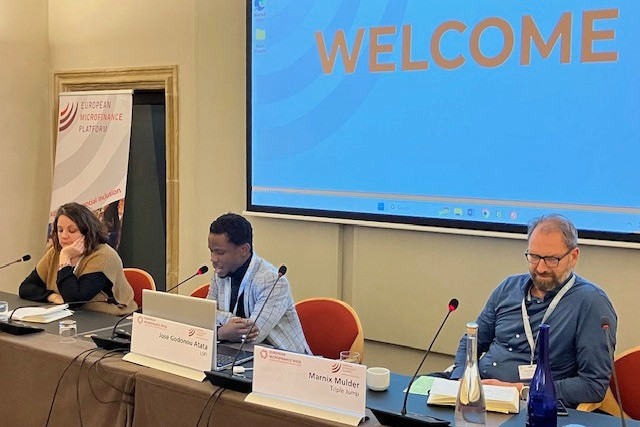José Godonou Atata, stakeholder coordinator at the Luxembourg Sustainable Finance Initiative (LSFI) and the moderator of the “Conquering New Frontiers with Blended Finance” panel, set the scene at the European Microfinance Week conference on 15 November 2023 by providing the definition of blended finance as per the Organization for Economic Cooperation and Development. “It consists of the strategic use of development finance for the mobilisation of additional finance towards sustainable development in developing countries.”
Godonou Atata explained that the goal is to attract commercial capital that complements financial resources from developed countries and technical assistance to projects that contribute to sustainable development and support the implementation of the Paris agreements.
[We] try to go where no one has gone before.
“There is an aspiration to close the SDG funding gap that is estimated between $5trn to $7trn a year…and the gap has been widening,” said Marnix Mulder, market development director at Triple Jump, an impact investment manager. “We need to have more investable projects… to fulfil that finance gap… to attract more conventional capital that operates with more conventional risk-adjusted rates of return.”
No blended finance without catalytic capital
“Catalytic capital is quite essential because you only have blended finance if there’s somebody willing to put in a tranche of money that is having high risk and low return,” stated Mulder.
The role of the Luxembourg Development Cooperation Agency (Luxdev) is to “make markets in emerging frontiers… stronger… and more attractive to investors,” said Francesca Randazzo, expert in sustainable & innovative finance at Luxdev. Mulder aims to bring together NGOs, governments and institutional investors “and try to go where no one has gone before.”
Helping them help themselves
“Public financing is meant to be short in time and is not meant to be there forever,” said Randazzo. You can claim to have an impact in terms of sustainability only when an ecosystem of local or regional private investors participate financially in community projects.
Randazzo explained that Luxdev supported the regulator in Vietnam to improve their oversight in order to attract investments to the country. Similarly, Luxdev will launch a project next year in Rwanda to support the country in becoming a sustainable financial centre.
Many Luxembourg ministries involved in impact investment
The government of Luxembourg may turn to Luxdev for investment management, the latter investing in a first-loss tranche in impact funds. “We don’t expect returns or high returns and we are willing to take all the risks,” stated Randazzo. Luxdev also provides technical assistance facilities (TAF), which are grants to impact funds to pay for weather risk systems, insurance, etc.
Alternatively, the investment configuration may reach out to several Luxembourg stakeholders. For instance, the investment in the sustainable management of secondary forests in Central America was financed by ministry of the environment and the ministry of finance (both taking the first loss tranche but with a strategic role on the board of the fund), whereas the ministry of foreign affairs financed the TAF, which is administered by Luxdev.
Building up your case
More generally, Mulder commented that one must prove that the investment case works and build a track record that will have a “demonstration effects.” He thinks that one can start attracting private investors only after that.
Triple Jump was funded in 2006, “supporting microfinance institutions into the capital markets… and improv[ing] their performance.” Mulder started their initial funds with a “very high-risk profile, very small tickets, so concessional kind of capital.”
“Blending” can take several forms. To improve access to finance to the so called “missing middle” (small and medium enterprises that are too big to get financing from microfinance institutions and too small to access traditional banking services), Mulder explained that they take anchor positions in funds in Africa and Afghanistan to attract other investors to step in.
Creating “something in motion”: a catalyst
Mulder claimed that their micro housing fund has contributed to improve the housing conditions of over a million people. The fund, fostered by , a nonprofit housing organisation, initially had a leveraged structure that included $10m in equity and $90m in debt, a structure that was supported by the issuance of letters of credit by HFH.
Furthermore, Mulder observed that through technical assistance activities, affordable housing was deployed and banks improved their housing products. He also noted a “leverage effect” after the loan was repaid as banks continued to provide housing finance. He reported that the initial $100m of loans proliferated into $1bn of follow-on housing loans.
“Skills and size matter”
“Providing housing loans… that are commercially attractive… for microfinance institutions… makes it easier to be financed… over time,” said Mulder. He explained that only relying on concessional resources (below-market interest rates) restricts impact as it instills doubt in investors on the economic viability of the projects. Once it is demonstrated that these projects can be implemented successfully, the arrival and the sourcing of private funding structures have a multiplier effect thanks to leverage.
Mulder explained that the fund has taken a systemic approach whereby it is not only looking at supplying affordable housing loans but also at promoting changes in the larger housing system. As such, they will invest in the SMEs that are part of the value chain in the housing sector to improve the supply of affordable housing products. He noted that the concept will be integrated in their upcoming MicroBuilt 2 fund.
This article was published for the Delano Finance newsletter, the weekly source for financial news in Luxembourg. .
